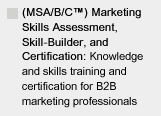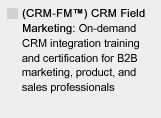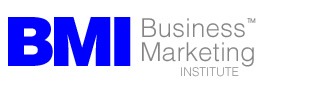MAKE SURE YOU CONTINUE TO RECEIVE EACH ISSUE OF TUESDAY MARKETING NOTES—CLICK HERE TO RENEW YOUR FREE SUBSCRIPTION (IF YOU'VE ALREADY SUBSCRIBED, NO NEED TO RE-SUBSCRIBE)
Your Best Marketing Safety Net: Using Direct Mail, Google AdWords, and Fractional Ads to Test New Marketing Messages, Offers, and Methods
by Eric Gagnon
As the "new normal" grinds on, the uncertainty many of us are feeling about business conditions, especially as those conditions affect our own marketing programs, still remains. How can you be sure that what works today in your marketing program won't suddenly stop working tomorrow, due to the current economy and its effect on your company's market? Worse yet, what happens when the marketing methods you're using now are already in trouble?
Of course, you can never be sure that your current marketing plan will always be successful. But one thing that's totally within your control is your ability to continuously test a wide variety of new marketing methods, offers, and messages as insurance against a falloff in response in any of your current marketing activities. This was certainly true when the economy was running smoothly, but now it's imperative to use testing to keep all of your marketing options open.
Use Direct Mail, PPC, and Fractional Ads to Test New Elements and Methods in Your Marketing Program
Among the variety of ways you can run market tests, print direct mail is the most effective and least expensive means for market-testing sales copy, promotions, pricing, and other critical aspects of your marketing program. Online pay-per-click (PPC) advertising programs, such as Google AdWords, can also be used as a powerful, effective, cheap, and very fast method for testing many aspects of your marketing program's sales copy, benefits, headlines, pricing and other key product positioning features, for all other marketing programs, not just online advertising. Fractional print advertising, while limited in its effectiveness, can also play a part in your testing program. This week, we'll describe each of these major testing methods, and how you can start using them in your own marketing program.
Google AdWords Online Pay-Per-Click Testing
Online text search pay-per-click (PPC) advertising programs, such as Google AdWords, are naturally suited to market testing. The main advantage of using PPC advertising is speed of result: You can test an infinite combination of keywords, text ads, headlines, and landing page promotions, and you can see the final result faster, and with more precise measurability, compared to any other form of market testing or advertising.
The big disadvantage to PPC advertising is that, for many specialized B2B products, the volume may not be there (yet) to generate the sales response to justify spending a lot of time running PPC ad programs. Also, PPC advertising is more suited for selling some types of products, such as IT hardware and software, than others, since computer-bound IT buyers may be far more likely to use Google and other search engines daily to find products of interest, compared to prospects in other fields.
It could be that a lot of the folks in your market aren’t sitting in front of their computers all day searching the Internet, like IT people. If this is true for your market, then you may not generate a high enough volume of traffic and sales response to make PPC advertising a viable part of your marketing program.
So, your success in using online pay-per-click (PPC) advertising to market and sell your company’s (or client’s) product depends entirely on whether or not there are enough Internet users in your market who are searching for products like yours to justify the effort. You won’t know this unless you get out there and start running AdWords tests to see whether or not PPC advertising works for your company and this, once again, is why testing is important in your marketing program.
Using PPC for Quick Sales Copy Testing
However, even where the response volume may be low, AdWords is an excellent method for quickly testing the sales appeal of headlines, copy, and benefits for B2B products and services, and you can use sales copy that tests well in AdWords in other, “offline” advertising programs in other marketing media, such as print advertising and direct mail.
Since there’s no reason why headline or copy that pulls well in an AdWords text ad can’t be just as compelling when used in a mailing piece, a printed display ad, or any other offline deliverable, keyword search advertising is an ideal tool for dialing in the best headlines and major sales benefits you can use in other types of marketing media. For this reason, you should strongly consider using Google AdWords programs as small test beds for trying out new sales copy ideas, headlines, pricing options, and promotions.
You can run very useful tests of sales copy, new positioning appeals, pricing, and promotions by linking keywords in your PPC program to a free information premium (your actionable offer), such as a report or white paper, accessible at individual landing pages that are set up to track the number of page accesses and downloads of the free information premium being offered.
While you may not receive a large sales response from PPC and other Net-based marketing programs for your company’s specialized business-to-business product, using PPC as a means to get fast feedback on tests of basic sales copy benefit appeals makes it an excellent testing feature. It’s also good to start using this new medium now, because there’s no doubt that online and PPC advertising will be playing a larger and more important role in your marketing program.
Using Small Mailings for Market Testing
Direct mail allows you to control who receives your deliverable, and produces test results which can be more cleanly separated by your test of each mailing list selection, deliverable, sales copy, price offer, or other variable used in your test.
Direct mail is also attractive because you can run tests at lower cost, and the results are “scalable,” in that response from larger mailings are reasonably predictable from the results of a relatively small mailing test.
Getting Measurability with an Actionable Offer
You can build measurability into your market testing projects (or any marketing activity) by giving your prospects a reason to contact your company, and you do this by using an actionable offer that is valuable to your targeted prospect. The best actionable offers give your potential prospect something that is seen as being valuable to them. Informational premiums are ideal: free white papers, reports, books or booklets, DVDs, or software. The more these premiums relate to the on-the-job needs of the prospects in your market, the more attractive they will be to your prospects.
For example, if you were targeting sales of a CNC machine tool accessory to smaller machine shops and other operations with less than 100 employees, you might publish a white paper detailing the specific needs and applications of concern to owners of these operations, and describe how your company’s products address their needs by solving a problem which is unique to owners and operators of these kinds of businesses. Informational premiums that solve the reader’s problems, and position your company as the leading expert in solving these problems, make compelling actionable offers.
Promotional offers are also attractive to first-time prospective buyers: Discount savings, free trial offers, or free samples, depending on your product and its price level, often give potential prospects the extra motivation they need to take the first step to contact your company.
The terms of your actionable offer need to be to compelling enough to strongly motivate potential prospects to contact you to close the loop on the offer, and, in your call to action, you need to make it clear to prospects what it is you want them to do next to contact your company: Visit your Web site to download a white paper or report, call your company to speak to a sales rep, or contact a distributor.
Set up your actionable offer for measurability: Use a dedicated Web URL for each mailing piece to track responses to each mailing in your test. Using a single word behind a slash after your Web site domain makes the URL simple enough for your reader to remember, like so:
www.yourcompany.com/savings
—assign a specific URL for each mailing piece you are testing, and track responses to each of these URLs after you mail.
Plan Ahead to Measure Response on Your Test
While you’re producing the mailing pieces, plan ahead to track and measure responses:
• To track access to specific URLs on your site, alert your IT department, or whoever else is in charge of your company’s Web site, to start counting page accesses to these URLs. Use a simple e-mail signup form to gather e-mail addresses from prospects who respond to your test;
• Print a key code below the toll-free number on your mailing piece. Ask your sales reps, or whoever else answers incoming calls from potential prospects on your company’s “800” line, to ask callers for the key code on the mailing piece, and make sure these responses are logged, either on paper, or in your company’s CRM system;
• If your mailing piece is using a printed reply card, make sure you are intercepting these cards in your company’s mail room, and logging responses by mailer and test panel by the key code printed on the reply card
If your company’s sales and marketing team isn’t currently using a CRM system, running a mailing test is a perfect time to start using one to log and track responses from your test. If you don’t have a CRM system, a spreadsheet will do just fine for recording and tracking sales response from your marketing projects.
However you choose to track responses, do this early: Setting up your tracking, logging and measuring process for your test mailing before the pieces are printed saves you from turning this into a haphazard, last-minute fire drill after the mailing pieces are dropped, the ads are placed, or the AdWords program is activated.
Quantities to Test for Mailings: How Many is Enough?
For a direct mail test involving three different mailing pieces testing three different positioning, sales copy, or promotional approaches, I usually like to test at least 2,500 names for each test mailing, but 5,000 is a better quantity to mail if possible, because it provides you with a more reliable basis for predicting future response. This means a typical test involves mailing between 7,500 to 15,000 total pieces. However, you can run much smaller mailings at far less cost, and still gather useful information for your testing purposes.
Using “Nth-name selection:” When testing, you can get an accurate, representative sample of any large mailing list by requesting an “Nth-name selection” of this list. For example, to order a test sample list of 5,000 names from a large trade publication mailing list of 100,000 subscribers, request an “Nth-name select” of every 20th name throughout the entire randomly-sorted list to receive a representative sample of 5,000 names (i.e., 100,000 names, divided by every 20th name=5,000). The publication retains a record of the names you ordered for your test, and can omit these names when you place a re-order for a new list with them for another mailing.
What to Test?
While you can use direct mail to test just about any aspect of your marketing program, a typical testing scenario for most marketers involves testing different positioning and sales copy for a product, mailed to the best mailing list available (usually the leading trade publication for the industry, selected by job title and/or industry). This will usually give you a very good handle on response to the message, offer, product, or promotion you are testing, against a representative sample of potential prospects in your market.
Test panels: In direct mail jargon, any variable you test is called a test panel. Using a spreadsheet, you can create a matrix row-and-column chart for your test, showing test panels for each of your testing elements.
Measuring response: When running your first direct mail test, you’ll receive 90% or more of your total responses to your mailings in 3-4 weeks. By then, if you’ve been carefully logging your results, you’ll know if one or more of your test mailing pieces are pulling well ahead of others in your test, which mailing lists pull better than others, or if direct mail is a viable marketing method for your company’s marketing program.
Response rates: What’s a good response rate for B2B direct mail? Response rates for test mailings to new lists vary widely, from .5% or less, to 5% or more, but 1-2% is a reasonable number for response from "cold" mailings sent to prospects on rented mailing lists in B2B markets, and can be a useful benchmark for analyzing your mailing’s return.
Using Fractional Print Display Ads for Market Testing
Can print advertising be used in the same fashion to test copy, promotions, etc.? Yes, but only if you understand its limitations. As a technique for testing sales copy and positioning, print advertising is generally a less attractive option compared to using direct mail testing. First, print advertising is generally less effective at generating measurable sales response compared to other marketing methods. Second, trade publication print advertising schedules require longer lead times than direct mail, which means you’ll wait longer to get actionable test results for your marketing program. Third, because some readers won’t usually remember where they saw your ad, it is more difficult to accurately track and measure response from advertising.
Despite these drawbacks, print advertising can play a valuable role in your marketing program, and can be used not only for market testing purposes, but can also be used for testing ad placements to assess the viability of adding print advertising to your marketing plan.
Which ad page size to use? One of the biggest myths in marketing is that you have to run full page ads to get the best results from an advertising program. If you master the techniques of making smaller ads “act big,” (we covered some of these techniques here), you don’t need to buy full pages. You can run half, quarter, or even smaller ad page sizes if you are using a strong, actionable, measurable offer to drive readers from the print ad to take action by going to your Web site or calling your company.
Techniques for testing print advertising: The ideal testing method for running print advertising is the “A/B split,” where two different ad layouts are run in alternate printed copies of the same issue of a publication. Unfortunately, A/B split testing is not available for many trade publications. As an alternative, you can run two different fractional ad layouts in the same publication, or (better yet) a different layout of the ad in two separate issues to test print ad layouts in the publication. Tag each ad with its own unique URL and log the responses to your actionable offers. Not the cleanest testing technique, but it’s the best way to determine if print advertising works for your company’s marketing program and, if so, which copy approaches work best.
How Much to Spend for a Testing Program? Not as Much as You Think
The good news about testing is you don't have to spend a lot of money to run an ongoing testing program. You can get started in Google AdWords for a few hundred dollars, and you can run some basic direct mail tests and fractional ads for a few thousand dollars. No matter how small the test, if you accurately track and measure response you will always learn something new about your market, the best offers to use to draw response, and how well (or poorly) potential prospects will respond to the sales copy you place before them.
Dedicate a small percentage of your budget to running a small number of tests every month and your testing program will not only more than pay for itself when you discover a new copy approach, layout, or marketing method you can scale up in your main marketing program, you might just uncover a new way to generate leads that arrives just in time to keep your marketing program effective and productive in the uncertain months ahead.
Comments? Questions? Send them to me at: eric@businessmarketinginstitute.com
Eric Gagnon (eric@businessmarketinginstitute.com), a director with the Business Marketing Institute, is author of The Marketing Manager’s Handbook and The CRM Field Marketing Handbook.







